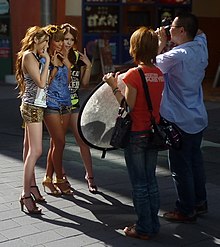Gyaru-moji (ギャル文å—, "gal's alphabet") or Heta-moji (下手文å—, "poor handwriting"), is a style of obfuscated (cant) Japanese writing popular amongst urban Japanese youth.
Like the English phenomenon of SMS language, it is most often used for sending cell phone text messages, but while text is used as a form of informal shorthand, a message typed in gyaru-moji usually requires more characters and effort than the same message typed in plain Japanese. Since writing in gyaru-moji requires extra effort, and due to the perception of confidentiality, sending gyaru-moji messages to a peer is seen as a sign of informality or friendship. The origin of this style is unclear but it has been proposed that magazines targeted at teenage girls first made it popular, and the phenomenon started to gain wider attention in media around 2002.
The style has been met with increasing criticism, as its use continues to expand. Reported instances of girls using the writing in school work, OLs (Office Ladies) adopting the style in the workplace, and gyaru-moji being used in karaoke subtitling, are examples of this.
Formation

Like leet, gyaru-moji replaces characters with visually similar characters or combinations of characters. Hiragana consisting of connected strokes are replaced by symbols or Greek letters: for example, ã™ (su) may be rendered as the section symbol §. Hiragana consisting of detached elements are replaced by sequences of kana, Western letters, or symbols. For example, ã» (ho) may be typed as |ã¾ (vertical bar and hiragana ma) or (ã¾ (open parenthesis and ma), ã' (ke) may be typed as レナ (katakana re na), Iナ (capital i, na), or (†(open parenthesis, dagger), and 㟠(ta) may be typed as ナ= (katakana na, equals sign) or †ã" (dagger, hiragana ko). Katakana is frequently replaced by similar-looking kanji, such as 世 for ã‚» (se) or å¹² for ム(chi), in a reversal of the process that turned man'yÅgana into kana. Kana and rÅmaji may be mixed freely, even within a word, and Latin letters in rÅmaji may be replaced with similar-looking Cyrillic letters, such as replacing N with И (Cyrillic I). Compound kanji are decomposed into left and right elements, which are written as individual kanji or kana. For example, the kanji 好 in 好ã, meaning "like, enjoy" may be split into 女å (the kanji for woman and child, respectively).
In addition to the basic obfuscation provided by character replacement, another technique used to disguise the content of the message is to use vocabulary and grammar that is uncharacteristic of standard usage. Combined with character substitution, this can make the meaning of the message almost unintelligible to those not “in the knowâ€. This is analogous to the use of leet’s specialized grammar. However, the flexible nature of the Japanese language means that although gyaru-moji phrases sound peculiar to someone expecting formal or even commonly colloquial Japanese, they are often technically still grammatically correct. For example, the sentence 「ç§ã¯ä»Šã¨ã¦ã‚‚良ã„気分ã§ã™ã€‚〠(“Watashi wa ima totemo yoi kibun desu.â€) is “Right now I am feeling very good.†in standard normal-polite Japanese. By first rewording this as 「超気æŒã¡ã„ã„ï¼ã€ or 「ãƒãƒ§ãƒ¼ã‚モãƒã‚¤ã‚¤ï¼ã€ (“ChÅkimochi ii!â€) â€" which roughly translates as “(I have a) Super good feeling!†â€" and then converting to gyaru-moji to get ã€Œèµ°å¬ æ°£ æŒ ã¡ ãƒ ãƒÂ !〠or 「于∋â"€â‰ モ于イイï¼ã€, the message could prove difficult for those not versed in the style to understand.
Conversion chart
The original Japanese hiragana followed by romaji, and then various versions of the Japanese character in gyaru moji.
Compound kanji
Here are some examples of gyaru-moji created from compound kanji. The kanji characters are followed by their reading and meaning, and the gyaru-moji derived from them:
- ç§ (watashi, "I") â†' 禾ãƒ
- 神 (kami, "god") â†' ãƒç"³
- æž— (hayashi, "woods") â†' 木木
Examples

References
See also

- Japanese typographic symbols for explanations of some of the above Japanese symbols.
- Emoji
External links

- Japanese girls devise their own written language

Posting Komentar